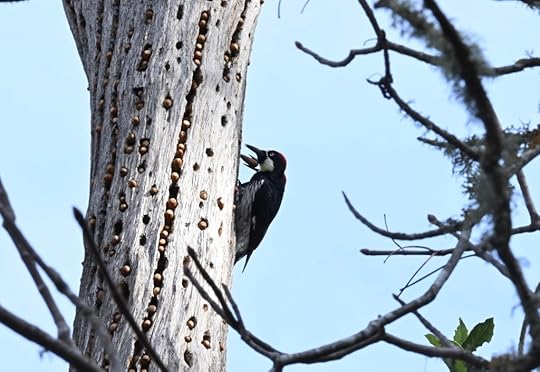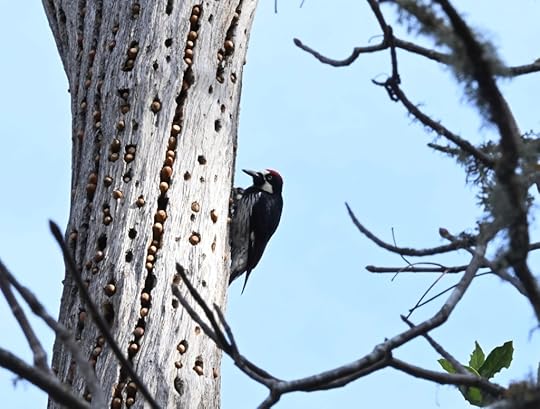Do acorn woodpeckers kill the trees they use to store nuts?
In my opinion, it’s hard to find a better time of year to go hiking in California. It’s cold enough to keep bugs away, and yet there are plenty of fall leaves and birds to be seen. Case in point, my husband and I went hiking in a wooded area near Portola Valley, California last week and came across a flock of acorn woodpeckers busily stashing acorns into the dead half of a giant tree.
My husband took a lot of pictures of this fascinating and new to us behavior. Our minds were full of questions: Are they storing those nuts? Retrieving them? Did they kill that half of the tree by making all those holes or was that bit already dead before they started drilling?
We stood there watching the birds long enough that our fellow hikers began commenting to us about our own behavior.
“Haven’t you ever seen woodpeckers before?”Reader, yes, I have. But sometimes when you go out and into nature, nature does something so interesting that you want to stop and watch it for a while. In our case, for about twenty minutes. I have seen acorn woodpeckers frequently since moving to California, but I have rarely seen so many when I had such a clear view of what they were doing and how they were working together to do it.
 Although at first glance this appears to be a picture of a single woodpecker with two beaks, it’s actually two woodpeckers working side by side. The bird closest to the camera was focused on drilling holes, the second bird was attempting to find the perfect spot for the acorn in its beak. (Photo: Michael Howell)
Although at first glance this appears to be a picture of a single woodpecker with two beaks, it’s actually two woodpeckers working side by side. The bird closest to the camera was focused on drilling holes, the second bird was attempting to find the perfect spot for the acorn in its beak. (Photo: Michael Howell)One of the hikers passing by told us that the acorn woodpeckers were storing nuts for the winter. They like to store them in tight holes, she said. As the acorns dry out, they shrink, so the woodpeckers will move them to a smaller hole to get the right fit. The goal is to have the acorns held tightly enough that squirrels can’t pry them loose. Watching the colony of woodpeckers in action, the hiker’s explanation seemed plausible, but if I’ve learned anything over the years, it’s that I always need to check my sources. Besides, we didn’t think to ask the hiker our real question:
Do acorn woodpeckers kill the trees they use to store all those nuts?I have been casually interested in birds for a long time and have accumulated quite a collection of bird guides at home. So I pulled out four of my guidebooks to North American birds to see what they could tell me about the acorn woodpecker and its December afternoon behavior.
I started with our biggest book, Birds of North America: The Complete Photographic Guide to Every Species from the American Museum of Natural History (2009). It gave us visual confirmation that we had identified the birds correctly. They are definitely acorn woodpeckers. According to this guide, the acorn woodpecker is the only North American woodpecker that stashes nuts in trees for winter snacking. The guide goes so far as to describe their acorn-stashing behavior as “obsessive,” and says that acorn woodpeckers prefer old forests because their trees have softer wood and higher acorn yields.
 Obsessive? Just because the woodpeckers have already stashed hundreds of nuts in what appears to be vertical stripes all around this one dead tree limb? Rude. (Photo: Michael Howell)
Obsessive? Just because the woodpeckers have already stashed hundreds of nuts in what appears to be vertical stripes all around this one dead tree limb? Rude. (Photo: Michael Howell)From Birds of North America, I also learned that acorn woodpeckers depend on oak trees, so tend to live in areas where there are several types of oak trees. This gives them a backup source of acorns, if one type of oak tree should fail to produce in any given year. This explains why they are so abundant in the Portola Valley, which is home to several types of oak trees, including coast live oaks, blue oaks, tan oaks, black oaks, and canyon live oaks. Lots of choices for the discerning, yet obsessive acorn collector.
The National Audubon Society’s Field Guide to Birds Western Region added the tidbit that acorn woodpeckers don’t just use dead oak branches to stash their hoards, they will also create and maintain their provisions in mature or dead pines, fence posts, or Douglas fir trees, all of which can be found in Portola Valley as well.
Did you know that acorn woodpeckers don’t just eat acorns?I know, all the visual evidence in this post suggests otherwise, but in suburbs and agricultural areas, they will happily gather walnuts and almonds too. For the most part though, acorn woodpeckers treat their hoards of gathered nuts as emergency backup provisions. Only about half of the acorn woodpecker’s diet consists of nuts. They much prefer to eat flying insects whenever they are available. According to our copy of the National Geographic Backyard Guide to the Birds, acorn woodpeckers will also happily snack on ants and sugary tree sap in the spring and summer.
Still, acorn woodpeckers spend a lot of effort on their annual acorn harvest, and they apparently get just as irritated with marauding squirrels as any novice gardener. Acorn woodpeckers pack the nuts as tightly as they can in those little holes to keep the squirrels from stealing them. The guide books also claim that some woodpeckers in the colonies are assigned to guard the stash, attacking squirrels who get too close. Unfortunately, we didn’t get to see any of that in person.
But what about the trees? Do acorn woodpeckers kill their granary trees? Most of Michael’s photos are zoomed in on the birds themselves, for obvious reasons, but in this one you can see that the bird is working on a dead section of an otherwise live tree. (Photo: Michael Howell)
Most of Michael’s photos are zoomed in on the birds themselves, for obvious reasons, but in this one you can see that the bird is working on a dead section of an otherwise live tree. (Photo: Michael Howell)This was all fascinating, but none of it answered our original question. Do acorn woodpeckers kill the trees they use to hoard all those nuts?
Thank goodness our final off-the-shelf bird guide addressed this. The Young Birder’s Guide to Birds of North America (Peterson Field Guides) states that acorn woodpeckers have been known to stash thousands of nuts in a single tree, known as a granary, for later use without killing the tree. Presumably this is because the birds prefer to use already dead branches (or fence posts) as their granaries.
Colonies of acorn woodpeckers work together to create these granaries and will reuse them year after year, but food storage is not the only group project acorn woodpeckers work on in any given year. Several of my guides mentioned that acorn woodpeckers also work collectively to incubate and raise their young. Reading this, I couldn’t help but think of Mama Duck, who did not find Papa Duck’s presence helpful in the least.
Want to read more but don’t want to buy all those books?Cornell Labs’ All about Birds website has a nice entry on Acorn Woodpeckers and their acorn hoarding behavior, which you can find here.
Print References Consulted for this PostAlderfer, J. & Hess, P. (2011). Backyard Guide to the Birds of North America. National Geographic.
Farrand, J., & Udvardy, M.D.F. (2018). National Audubon Society Field Guide to Birds Western Region. Alfred A Knopf.
Thompson, B. (2012). Peterson Field Guides: The Young Birder’s Guide to Birds of North America. Houghton Mifflin Company.
Vuilleumier, F. (Ed.). (2009). Birds of North America: The Complete Photographic Guide to Every Species. American Museum of Natural History.
(Note: The above list includes affiliate links to Bookshop.org. If you use them to purchase books from Bookshop.org, I’ll earn a small commission. Read more about why I decided to use affiliate links here.)
Related LinksNative Trees of Portola Valley (Town of Portola Valley) Acorn Woodpecker (All About Birds, CornellLab).


